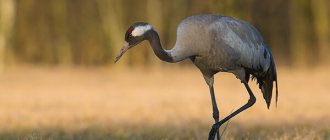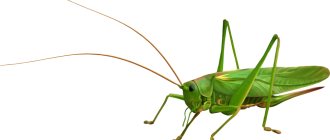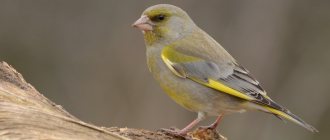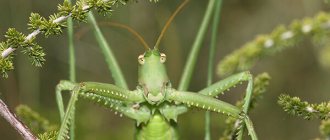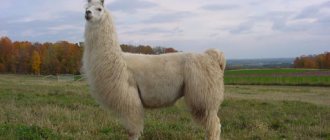Review author: “ZooVita”
Probably everyone has heard a grasshopper chirp at least once. When catching a grasshopper, most people are accustomed to thinking of a small green insect. However, this amazing representative of the Orthoptera order is distributed almost everywhere, and each subspecies has a lot of phenotypic features.
More details and characteristics of each variety can be noted in the photos of grasshoppers presented in entomological manuals.
A little anatomy
The body can be from 1.5 to 15 cm in length. It can be conditionally divided into three parts: head, chest, abdomen. There are two pairs of wings. On the massive head there are organs of touch (whiskers) that are longer than the body. The eyes are big.
Males are smaller than females. 3 pairs of legs. The chirping sound is made by the elytra, one of which is a “bow”, the second is a “resonator”. Each variety has its own sound scale. The ears are located on the front legs.
If you carefully look at the photos of grasshoppers, you can see a lot of interesting and unusual things.
Larva
Grasshoppers are insects with incomplete metamorphosis, that is, their larva resembles a smaller copy of the adult, only without wings. The ancient genus of Orthoptera has reached our days from distant times, when the coal seams were formed, and has not changed at all since then.
Grasshopper larva
The life of a green grasshopper does not begin in a meadow, but in the soil, at a depth of about 5-7 centimeters. There the insect emerges from the egg and begins the difficult journey towards the sun. The first instar larva (that is, before the first molt) is half a centimeter in size and is dressed in a whitish case that fits tightly, with a bubble in the back of the head. Moving like a worm, it moves upward, and the bubble, swelling and falling, serves to push apart the soil particles. Having encountered a stone on the way, the larva is doomed, because it can only move in a straight line. There are about 60 eggs in the clutch, but only the strongest and luckiest, about 10%, come to the top.
At the top, the insect takes off its temporary “space suit.” After waiting a little for the chitinous covers to harden under the sun, the larva begins to feed. She prefers the most tender parts of the leaves. During the season, the insect molts several times, increasing in size until it reaches the adult stage. As the larva grows, its menu also undergoes changes.
In middle age, the basis of the diet consists of grass seeds in the stage of milky ripeness, but the young grasshopper already shows predatory tendencies, destroying clumsy aphids and clutches of other insects encountered along the way. Hairless caterpillars are readily eaten. Gradually, the jaws become stronger, and older larvae easily cope with small locusts.
Chirping, what is this?
Above we briefly explained how a grasshopper chirps. Now let's look at the process in a little more detail.
The left elytra is equipped with a membrane with a special serrated vein, which is called stridulatory. It is she who plays the role of a “musical reed”.
On the right there is a resonator membrane. To produce a chirping sound, you need to vibrate the elytra.
The melodies and volume are different, depending on the type of insect. The sounds are most often made by the male. However, there are several species where the female shows her musical abilities.
Menu
What grasshoppers feed on crops harms farmers. They love to eat grape buds and flowers. Did you know that the grasshopper is primarily nocturnal? But during the day he hides in secluded places, and comes out to hunt only at dusk. By the way, he is not such a harmless insect. In nature, grasshoppers are actually predators. And although their diet includes plant foods, the main menu consists of small butterflies, mites, and caterpillars. Hiding in ambush, the grasshopper waits for prey and with its powerful paws that are in front, grabs the victim. Then the “hunter”, using strong jaws, shreds the caught insect and then eats it. The size of the prey matters; the victim should not be larger than the “hunter”. Grasshoppers, cannibals, do not exclude their small brothers, as well as their larvae, from their menu. They are not gourmets, so they eat everything that comes their way. As it turned out, plant and animal food is what grasshoppers eat.
Another very interesting fact. If you think that everything that jumps green or gray at you when you walk on the grass is grasshoppers, then no. They are often confused with fillies or representatives of the Locust family. He himself hid in a shelter and quietly dozed.
The life of grasshoppers is very short-lived, about one year, including the larvae.
Appearance
Externally they also differ. Grasshoppers are most often green. This color helps them camouflage themselves in foliage to make it easier for them to forage for food.
They have a movable head with sharp jaws. Powerful hind legs, short front legs. Incredibly long whiskers, which locusts do not have.
The body of the locust is brown or yellow, although it can be green, brown, or gray. The antennae are short, as long as the head. The hind legs are shorter but stronger. We hope it is now clear how to distinguish a grasshopper.
Nutrition
Among the small insects that inhabit the Earth, there are also cruel predators. Grasshoppers are one of them. These are natural, skilled hunters. They try to grab their prey with lightning speed, using their forelimbs. They feed on larvae as well as small insects, eating small locusts, mites and aphids.
Grasshoppers also eat beetles, butterflies, and caterpillars. In cases of shortage of other types of food, especially if they find themselves captive in a confined space, they are capable of attacking their own relatives in a wave.
Flowery grasshopper eating leaves
And sensing luck, the stronger will feast on the weaker with appetite, without hesitating at all. To get their required dose of nutrients, salts and protein, these insects are able to consume carrion and feces.
Grasshoppers can be attracted to plant leaves from plant food, but only on young shoots. There are species for which this type of nutrition is the main and even the only one.
However, in this case, the insatiability of grasshoppers sometimes harms cultivated and forest plants. But by eating harmful insects, in particular the Colorado potato beetle, which destroys potato plantings in huge quantities, grasshoppers turn out to be very useful.
Reproduction and lifespan
Insects living in the temperate climate zone begin to “make friends” in late spring and early summer. During this period, you can hear the roulades of the males.
Their seminal fluid is stored in a capsule covered with a nutrient mixture.
During mating, they attach the capsule to the female's abdomen. She begins to feast on the bait mixture, and at this time fertilization occurs.
Then a clutch is made, which can contain from 100 to 1000 eggs. It can be found everywhere: on branches, stems, bark, etc.
After a while, larvae appear, similar to grasshoppers, only miniature. They grow and shed. Shedding can be 4-8 times.
At this stage, wings appear. After the last molt, the grasshopper waits for the wings to be fully restored and sets off on the journey called life.
Do you want to know how long a grasshopper lives? Taking into account all stages of development, its life expectancy is just over a year. If you keep a record from the moment of “adult” life, then it turns out to be only one summer. As soon as cold weather sets in, the insect dies.
Secrets of the one sitting in the grass
Externally, grasshoppers are very similar to locusts. Main differences: locust whiskers are short, females do not have an ovipositor. Grasshoppers do not form a herd form; they bring more benefit to agriculture than harm.
The most typical representative of this genus for our latitudes is the green grasshopper (Locusta viridissima L.). The spectacular large insect lives where there is high grass. The protective coloring makes it invisible - when the grasshopper does not move or sing, it is not easy to notice. Along the sides of the insect’s body there is a lighter stripe, similar to a grass stem, which camouflages it even better. The female differs from the male in its larger size and the presence of a saber-shaped ovipositor.
Female green grasshopper
The grasshopper is secretive and timid. Disturbed, it either falls into the thick grass or jumps, opens large transparent wings in the jump and flies away from its pursuer. It is quite difficult to observe grasshoppers in nature, so much of their life remains “behind the scenes” for people, including their feeding habits. Meanwhile, this creature can transform in an amazing way: from a vegetarian it turns into an agile predator, capable of catching a victim twice its size.
Photos of grasshoppers
Adults
By July, the larva molts for the last time, becoming a full-fledged winged insect. On hot days, they tend to be motionless, with their forelimbs extended. This is similar to the pose of their close relative, the praying mantis. Like it, the grasshopper has grasping tentacles on the inside of its legs, but they are smaller. If a hunter comes across a careless victim, the grasshopper quickly kills it with a bite to the back of the head, eats it, leaving only the wings and head, and freezes again.
Males sometimes sing short trills in an attempt to win over females; most often, courtship occurs at midnight. The sound that a grasshopper makes is like hitting a metal surface, sounding barely audible, as if from afar. That is why the insect got its name.
Before sunset, the activity of adults increases . The grasshopper is helped to navigate in the dark by its whiskers and keen hearing. Some victims are twice the size of the hunter, but a powerful bite to the back of the head leads to the death of any of them. Even well-flying cicadas cannot escape. In areas with sandy soil there is another hearty food - khrushchi. At night, they begin to fly out en masse, and most of them, appearing on the surface, immediately turn into prey.
For some reason, only females show predatory tendencies, while males have more of a sweet tooth. Fallen berries or fruits are the main delicacy; the stronger individual does not allow competitors to eat, trying to drive them away with blows from the hind limbs. If the hunt is unsuccessful, the insect is content with plants. That is, the grasshopper is an omnivore.
Adaptation to the environment
Many animals eat grasshoppers, so they have to fight for life in all sorts of ways. The main defense is their powerful jumping legs, the ability to hide, the dismembering protective coloring, the spines with which they signal to their relatives about a threat, and the ability to bite. For example, a leaf grasshopper can bite through human skin until it bleeds. But there are also lesser-known protection options:
- When in danger, some species tear off their limbs. Insects easily part with one or two legs.
- Protective coloring may seem like a primitive protective method. Insects in nature also use other complex camouflage options. Mimicking leaves is a favorite technique that is often used. For example, the species Cycloptera elegans strongly resembles a dry leaf.
- Another genus Pterochosa is similar in color, pattern, and position of the veins to a withered and discarded leaf. There are spots on the wings that resemble pest damage to the foliage.
- Some varieties imitate a twig that sticks out of the trunk or lichen growths. There are species that can scare away the enemy with a squeal or cause disgust by belching their gastric juice.
Interesting Facts
The most interesting fact is that certain species can only be female. Moreover, these females lay eggs. However, they also produce exclusively females.
Some species of grasshoppers are popular food items in most Asian countries. They contain large amounts of protein and other nutrients. For European people, eating insects is considered something repulsive and causes strong disgust. But many peoples are happy to feast on such healthy and wholesome food.
Main dishes:
- insects fried in sunflower oil with garlic;
- fried dried grasshoppers taste like peanuts;
- deep-fried insects;
- grasshoppers in marinade;
- pancakes from assorted insects.
To catch the required number of grasshoppers, you need to go out with a net to a lawn with tall green grass.
The nutritional value of the insect is approximately 155 kcal per 100 g of product. The average amount of protein is much higher than in meat products and is 30 g.
In the near future, locusts, grasshoppers, mealworms, peacock and silkworm larvae, and crickets may very well become common and popular food items. Already today, many well-known manufacturers add insect flour during the production of products, thereby increasing its nutritional value and energy value.
Habitat
The homeland of the greenhouse grasshopper is East Asia, presumably China. It spread throughout almost the entire globe thanks to trade, namely the plants among which it lived quietly. Since he lived in a warm and tropical environment, he can be found mainly in greenhouses, greenhouses and greenhouses.
It is also found in bathrooms, sewers, bathhouses and basements. For its habitat, it chooses areas with a mild climate, where there is no sharp temperature difference from hot summer to cold winter. It was found in European countries, in the European part of Russia, Belarus, Ukraine, in South and North America.
Home maintenance
Many people may think that the singing grasshopper is an excellent pet to keep at home, but actually they are right. If you are not bothered by the fact that the pet will not live long, and will chirp without a female in a pair, then feel free to drag it home.
It is not difficult to make a terrarium for a singing grasshopper; any container with sufficient ventilation, approximately 40x30x30 in size for 2-3 singing grasshoppers, will do.
It is recommended to sprinkle sawdust at the bottom of the container, and place a jar of wet peat in the corner, into which the female will lay larvae. Any substrate will do, even soil from the street, with the proviso that you will then have to look for the eggs of the singing grasshopper by hand. You should also place various driftwood and sticks in the container to increase the usable area and allow the grasshopper to climb branches.
The singing grasshopper should be fed with insects; at home, you can feed it with food insects such as marbled or Turkmen cockroaches; you should also offer greens, in the form of various plants from the street.
Song grasshopper eggs along with the substrate should be removed at the end of August and placed in the refrigerator until the end of February. Then they are removed and the little singing grasshoppers are waited for to emerge.
Control measures
Methods to combat this insect have not yet been sufficiently developed. For preventive and exterminatory purposes, the following is recommended: it is advisable to locate tobacco plantations away from egg-laying sites (thrush and virgin areas) of the green grasshopper; treatment of the shag field and surrounding area with internal poisons; placement of bait with poison in pest habitats. This will require 30–60 kg of bran, 24 liters of water, 0.8–1.2 kg of arsenous soda.
Video
Lifestyle
Green grasshoppers lead a solitary lifestyle. They jump and fly very well. The length of the jump is several times greater than the length of the insect itself, and the flight speed can reach up to 1.5 km/h. Grasshoppers do not have a home; they are always found among grass, bushes and trees. In particularly hot weather, the insect hides in the greenery all day, emerging from shady shelters only early in the morning. We hear the ringing melodies of the grasshopper throughout the summer. The sound occurs as a result of vibration and becomes even louder if the insect raises its wings. Males sing to attract females or to let other males know that the territory is already occupied. The chirping of a grasshopper can most often be heard in the daytime and evening, less often at night.



